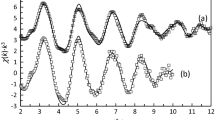Summary
-
1.
It has been shown that, when the halides of certain metals of the second and third groups of Mendeleev's system (ZnCl2, ZnBr2, AlCl3, CaCl2, MgCl2 and CdCl2) react with aliphatic (isopropyl alcohol, 1,1-dimethyl-ethanol, 2-methyl-2-butanol) and cyclic (cyclohexanol, menthol) alcohols, crystalline complex compounds of an acidic nature are formed. In this reaction, zinc halides unite with two alcohol molecules, aluminum halides with six, calcium and magnesium with three, and cadmium with one.
-
2.
When heated, the complexes formed with ZnCl2, ZnBr2, and AlCl3, unlike those formed with MgCl2, CaCl2, and CdCl2, break down with formation of new substances (\(C_\Pi H_{2_{_\Pi } } \), RX, ROH, MeX2, H2O, etc.). The compounds of MgCl2, CdCl2, and CaCl2 with alcohols decompose into the original components under these conditions.
-
3.
When these metal halide complexes are treated with organic acids (CH3COOH and others), esters are formed.
-
4.
In presence of moisture 2-methyl-2-butene, 2,3-dimethyl-1-butene, and 2,3-dimethyl-2-butene react with zinc bromide with formation of crystalline compounds of composition (C5H10)2·ZnBr2·2H2O and C6H12· 2ZnBr2·· H2O.
Similar content being viewed by others
Literature cited
B. N. Menshutkin, J. Russ. Phys. Chem. Soc., 37, 1063 (1905).
F. Roques, J, pharm. chim. (6), 1, 301 (1895).
S. E. Simons, J. prak. Chem. (2), 20, 371 (1877); G. V Chelintsev, J, Gen. Chem., 8, 588 (1938); A. S, Osokin, J, Gen. Chem. 8, 583 (1938); A. M. Dzhanpoladyan, Bull. Acad. Sci. Armen. SSR, 5, 43 (1952).
Fonzes-Diacon, J. pharm. chim. (6) 1, 59 (1895).
M. Loeb, J, Am. Chem. Soc. 27, 1019 (1905).
B. N. Menshutkin, J. Russ. Chem. Soc., 35, 610 (1903); 37, 1090 (1905); 38, 1010 (1906).
B. N. Menshutkin, J. Russ. Chem. Soc., 44, 1112 (1912).
A. V. Topchiev and Ya. M. Paushkin, Boron Trifluoride Compounds as Catalysts in Alkylation, Polymerization, and Condensation Reactions, State Tech. Press; Moscow, 1949.
G. Perrier and J. Pouget, Bull. Soc. chim. (3), 25, 550 (1901).
I. P. Tsukervanik, J, Gen. Chem. 5, 117 (1935).
Z. N. Nazarova and I. P. Tsukervanik, J. Gen. Chem., 14, 236 (1944).
D. R. Chesterman and A. S. Nickelson. J. Chem. Soc., 1936, 1303.
A. B. Kuchkarev, J. Gen. Chem., 22, 1127 (1952).
N. G. Sidorova and I. P. Tsukervanik, J. Gen. Chem., 10, 2073 (1940); 7, 641(1937); 20, 869 (1950); I. P. Tsukervanik, J. Gen, Chem., 15, 635 (1945).
I. Kondakov, Thesis “Syntheses in presence of ZnCl2 in the Aliphatic Series of Compounds”. Warsaw, 1894.
Yu. V. Koryakin, Pure Chemical Reagents, State Chem. Press, 1947.
A. R Abdurasuleva and I. P. Tsukervanik, Bull. Acad Sci. Uzbek SSR, No. 2 (1947).
Author information
Authors and Affiliations
Rights and permissions
About this article
Cite this article
Kuchkarev, A.B., Shuikin, N.I. Complex compounds of metal halides with alcohols. Russ Chem Bull 3, 397–403 (1954). https://doi.org/10.1007/BF01167816
Received:
Issue Date:
DOI: https://doi.org/10.1007/BF01167816



